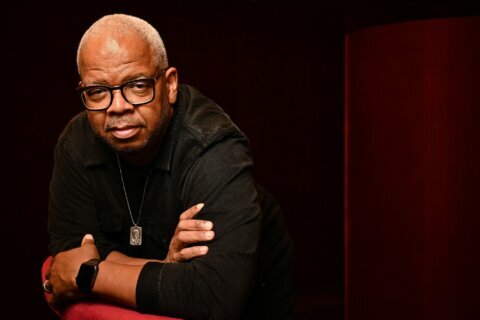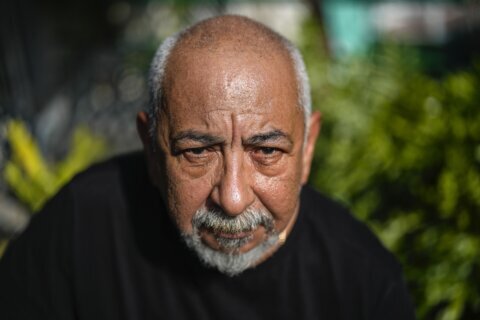Few bands shaped the punk rock and new wave genres more than Blondie.
Lead singer Debbie Harry peels back the curtain in the new memoir, “Face It,” which she’ll bring to D.C. for a book event at Sixth & I on Wednesday, Dec. 4.
“We do a conversation and show some video and some pictures,” Harry told WTOP. “Then the audience is included at the end. We do a Q&A.”
Joining her is moderator Rob Roth and guitarist Chris Stein, who wrote the intro.
“He’s one of my best friends, so I didn’t expect it to be too rotten,” Harry said. “I, of course, love what he wrote. We’re still working together after all these years, so I sort of expected it to be positive. He’s just a great guy. I’m so lucky that we met all those years ago and that we’re still friends and still working together. What more can I say? He’s one of my biggest influences and best friends.”
The book doesn’t mince words with rose-colored glasses. It kicks off with the opening chapter “Love Child,” about being born Angela Trimble in Miami and put up for adoption as an infant. She was raised in Hawthorne, New Jersey, where she was told a bedtime story at age 4 about a family who chose their child.
“I was gonna make light of this because I didn’t want to waste any time with anybody or paper for that matter,” Harry said. “I didn’t want to flower it up too much. I’m kind of a direct person and sort of just got right to it. … When you meet somebody who’s trying to dodge the issues or talk in circles around things, it seems pretty obvious. … I felt I should just tell the story and get right to it.”
Soon after, we read about how she met Stein to form Blondie in New York during 1974.
“[We met] at a performance of The Stilettos, which was one of the bands I was in,” Harry said. “I’ve been in a few other bands, but I didn’t go through all of that because they were very short-lived. The most formative bands I was in and the ones that taught me the most were The Wind in The Willows and The Stilettos. That’s when I met Chris at The Stillettos’ little gig in a little bar.”
How did they come up with the name, turning a cat call into a rock persona?
“I never thought being called ‘Blondie’ was derogative, I always thought it was kind of street noise, ya know?” Harry said. “It sort of was a different era then.”
As she writes in the memoir:
“I was playing up the idea of being a very feminine woman while fronting a male rock band in a highly macho game. I was saying things in the songs that female singers really didn’t say back then. I wasn’t submissive or begging him to come back, I was kicking his a**, kicking him out, kicking my own a** too. My Blondie character was an inflatable doll but with a dark, provocative, aggressive side. I was playing it up yet I was very serious.”
The next year, they added Clem Burke on drums and Gary Valentine on bass to become regular performers on New York’s East Village punk scene at CBGB.
“Hanging out at CBGB and putting the band together in some odd way was parallel to going to college,” Harry said. “We had to deal with everything right in front of an audience, learn the business and figure out what kind of music we were going to do. I guess every band does it a little bit different. We interviewed and played with a lot of different musicians for a couple of years. Finally, it solidified and we started working with the guys that were on the first album.”
That album was the self-titled debut “Blondie” (1976), which charted a few songs overseas with “X Offender,” “In the Flesh” and “Rip Her to Shreds.” The same went for their second album “Plastic Letters” (1977), which charted overseas with the singles “Denis” and “(I’m Always Touched by Your) Presence, Dear.”
But it was their third album that took them mainstream as “Parallel Lines” (1978) went platinum with a string of hits, including “One Way or Another” and “Heart of Glass,” which went all the way to No. 1 on the U.S. Billboard Hot 100 chart.
“We had the music for a long time and we were sort of diddling about with the lyric,” Harry said. “I don’t think it was any one place; I remember when we were living on The Bowery and had the first half of the line: ‘Once I had a love and it was a gas, soon turned out it was a pain in the ass.’ We wanted to change that but we couldn’t ever find the right thing. Then we got ‘Heart of Glass’ and that sort of locked it down. But at the time we didn’t realize it was also a movie title.”
Their fourth album “Eat to the Beat” (1979) went platinum again on the strength of “Dreaming” and “Atomic,” which reached No. 27 and No. 39, respectively.
In 1980, they contributed to the film soundtrack of Paul Schrader’s “American Gigolo” with the smash hit “Call Me,” which went to No. 1 for six straight weeks.
“At the time, I didn’t know that they had asked Stevie Nicks; I respect her very highly,” Harry said. “I guess it came through management, then we met with Paul Schrader and he showed us the footage. By then it was pretty much a completed film and we just went away and wrote the song. The song practically wrote itself.”
Their fifth album “Autoamerican” (1980), was another platinum seller, featuring another pair of No. 1 hits with “The Tide is High” and “Rapture,” while their sixth album “The Hunter” (1982) charted the single “Island of Lost Souls.”
Harry also explored other mediums, posing for Andy Warhol at The Factory for four acrylic and silkscreen ink-on-canvas portraits in different colors in 1980.
“I was very fortunate to be living in New York at the right time and place,” Harry said. “Living downtown, I actually met Andy on the street. … We traveled in similar circles and knew a lot of the same people, so eventually it evolved into a situation where I did sit for a portrait. I was just thrilled and honored to be any part of Andy’s world. He’s proven himself to be a great genius of our century.”
She also began starring in movies, including David Cronenberg’s body-horror “Videodrome” (1983) and Jon Waters’ indie musical “Hairspray” (1988).
“They’re both very intense personalities,” Harry said. “The two of them are both very creative in much different ways and the medium they’re working in is so intense. But the two of them have something similar actually: they’re smart, creative, they know how to get the best performance out of actors and they’re considerate. I was really lucky to work with either of them, let alone both.”
She even experimented with professional wrestling, referencing encounters with WWF superstars like Bret Hart, Andre the Giant and Rowdy Roddy Piper.
“We had met a manager named Shelly Finkel, who was involved in the fight game,” Harry said. “It was Shelly who got us to Vince McMahon and we started going to a lot of the matches. … What a crazy bunch of guys, just highly entertaining and a whole different world. Chris and I both as children had watched wrestling on TV, so we had a long love affair with pro wrestling.”
Along the way, Harry made a string of solo albums with “KooKoo” (1981), “Rockbird” (1986), “Def, Dumb & Blonde” (1989) and “Debravation” (1993) before reuniting with Blondie for “No Exit” (1999), “The Curse of Blondie” (2003), “Panic of Girls” (2011), “Ghosts of Download” (2014) and “Pollinator” (2017).
In 2006, the band was deservedly inducted into the Rock ‘n’ Roll Hall of Fame.
Now, it’s your chance to see the legendary rockers at Sixth & I and ask whatever questions you want. What does she hope fans will take away from the event?
“A lot of the people that come out perhaps went to some of those shows, not necessarily only Blondie shows but some of the other bands from the time,” Harry said. “After all these years, CBGB has become a trademark to a lot of people. You can even see CB’s cafes in different airports. It’s kind of amazing. It’s some sort of affirmation of the way our culture grows. It’s very interesting.”
Hear our full conversation below:








